# OSM Quickstart
[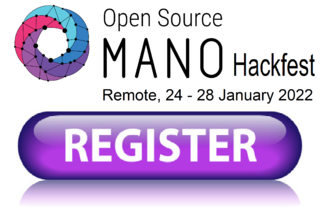](https://osm.etsi.org/wikipub/index.php/Next_OSM_Hackfest)
Open Source MANO (OSM) is an ETSI-hosted open source community delivering a production-quality MANO stack for NFV, capable of consuming openly published information models, available to everyone, suitable for all VNFs, operationally significant and VIM-independent. OSM is aligned to NFV ISG information models while providing first-hand feedback based on its implementation experience.
Release SEVEN brings a number of improvements over previous releases. For the full list of new features, please refer to the [Release SEVEN Documentation](index.md). For a comprehensive overview of OSM functionalities, you can also refer to the [OSM Scope and Functionality White Paper](https://osm.etsi.org/images/OSM_EUAG_White_Paper_OSM_Scope_and_Functionality.pdf) or to the release notes of previous OSM releases ([ONE](https://osm.etsi.org/images/OSM-Whitepaper-TechContent-ReleaseONE-FINAL.pdf), [TWO](https://osm.etsi.org/images/OSM-Whitepaper-TechContent-ReleaseTWO-FINAL.pdf), [THREE](https://osm.etsi.org/images/OSM-Whitepaper-TechContent-ReleaseTHREE-FINAL.pdf), [FOUR](https://osm.etsi.org/images/OSM-Whitepaper-TechContent-ReleaseFOUR-FINAL.pdf), [FIVE](https://osm.etsi.org/images/OSM-Whitepaper-TechContent-ReleaseFIVE-FINAL.pdf)).
**OSM in Practice**:
## Assumptions about interaction with VIMs and VNFs
The following figure illustrates OSM interaction with VIMs and VNFs:
- OSM talks to the VIM for the deployment of VNFs and VLs connecting them
- OSM talks to the VNFs deployed in a VIM to run day-0, day-1 and day-2 configuration primitives.
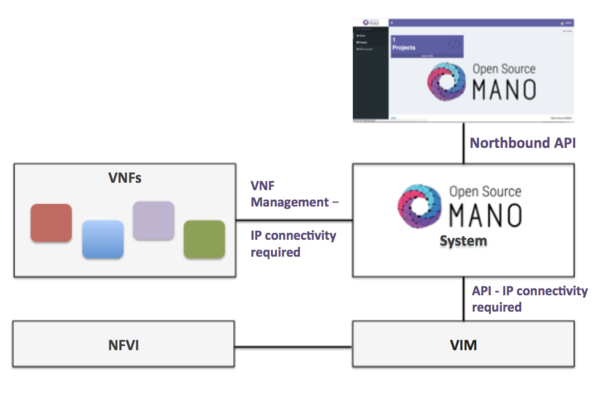
In order for OSM to work, it is assumed that:
- Each VIM has an API endpoint reachable from OSM
- Each VIM has a so called management network which provides IP address to VNFs
- That management network is reachable from OSM
## Installing OSM
### Default installation procedure
All you need to run OSM is a single server or VM with the following requirements:
- MINIMUM: 2 CPUs, 4 GB RAM, 20GB disk and a single interface with Internet access
- RECOMMENDED: 2 CPUs, 8 GB RAM, 40GB disk and a single interface with Internet access
- Base image: [Ubuntu18.04 (64-bit variant required)](http://releases.ubuntu.com/18.04/)
Once you have prepared the host with the previous requirements, all you need to do is:
```bash
wget https://osm-download.etsi.org/ftp/osm-7.0-seven/install_osm.sh
chmod +x install_osm.sh
./install_osm.sh
```
**TIP:** In order to facilitate potential trobleshooting later, it is recommended to save the full log of your installation process:
```bash
wget https://osm-download.etsi.org/ftp/osm-7.0-seven/install_osm.sh
chmod +x install_osm.sh
./install_osm.sh 2>&1 | tee osm_install_log.txt
```
You will be asked if you want to proceed with the installation and configuration of LXD, juju, docker CE and the initialization of a local docker swarm, as pre-requirements. Please answer "y".
#### Installation including optional components
You can include optional components in your installation by adding the following flags:
- **VIM Emulator:** `--vimemu` (more information [here](04-vim-setup.md#vim-emulator))
- **Fault Management features with ELK:** `--elk_stack` (more information [here](05-osm-usage.md#fault-management))
Example:
```bash
./install_osm.sh --elk_stack --vimemu
```
#### Installation on a standalone Kubernetes environment
From Release SEVEN, OSM can be deployed on a single host running a Kubernetes cluster. Although the default option is to use docker swarm, you can now tell the installer to use K8s as the container framework. The installer will install the required packages to run a single-node K8s cluster and will deploy the different K8s objects on it.
```bash
./install_osm.sh -c k8s
```
In addition, you can use the option `--k8s\_monitor` to install an add-on to monitor the K8s cluster and OSM running on top of it.
```bash
./install_osm.sh -c k8s --k8s_monitor
```
#### Other installation options
- You can also run OSM using a pre-built [vagrant](https://app.vagrantup.com/osm/boxes/releaseseven) image: [How_to_run_OSM_on_Vagrant](03-installing-osm.md#Vagrant-installation)
- For other special installation options, please refer to the [release documentation](index.md).
### Checking your installation
After some time, you will get a fresh OSM installation with its latest, pre-built docker images which are built daily. You can access to the UI in the following URL (user:`admin`, password: `admin`): [http://1.2.3.4](http://1.2.3.4/), replacing 1.2.3.4 by the IP address of your host.
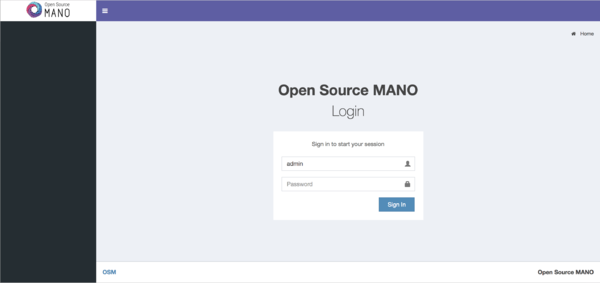
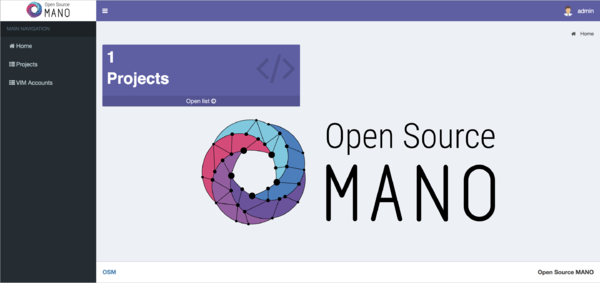
As a result of the installation, fourteen docker containers are created in the host (without considering optional stacks). You can check they are running by issuing the following commands:
```bash
docker stack ps osm |grep -i running
docker service ls
```
If the previous docker commands do not work, you might need to either reload the shell (logout and login) or run the following command to add your user to the 'docker' group in the running shell:
```bash
newgrp docker
```

At any time, you can quickly relaunch your deployment by using the pre-built docker images, like this:
```bash
docker stack rm osm
docker stack deploy -c /etc/osm/docker/docker-compose.yaml osm
```
To check the logs of any container:
```bash
docker service logs osm_lcm # shows the logs of all containers (included dead containers) associated with LCM component.
docker logs $(docker ps -aqf "name=osm_lcm" -n 1) # shows the logs of the last existant LCM container
```
OSM client, a python-based CLI for OSM, will be available as well in the host machine. Via the OSM client, you can manage descriptors, NS and VIM complete lifecycle.
#### Checking your installation when installing on K8s
As a result of the installation, different K8s objects (deployments, statefulsets, etc.) created in the host. You can check the status by running the following commands:
```bash
kubectl get all -n osm
```
To check the logs of any container:
```bash
kubectl logs -n osm deployments/lcm # for LCM
kubectl logs -n osm deployments/light-ui # for LW-UI
kubectl logs -n osm deployments/mon # for MON
kubectl logs -n osm deployments/nbi # for NBI
kubectl logs -n osm deployments/pol # for POL
kubectl logs -n osm deployments/ro # for RO
kubectl logs -n osm deployments/keystone # for Keystone
kubectl logs -n osm statefulset/kafka # for Kafka
kubectl logs -n osm statefulset/mongo # for Mongo
kubectl logs -n osm statefulset/mysql # for Mysql
kubectl logs -n osm statefulset/prometheus # for Prometheus
kubectl logs -n osm statefulset/zookeeper # for Zookeeper
```
Finally, if you used the option `--k8s\_monitor` to install an add-on to monitor the K8s cluster and OSM, you can check the status in this way.
```bash
kubectl get all -n monitoring
```
## Adding VIM accounts
Before proceeding, make sure that you have a site with a VIM configured to run with OSM. Different kinds of VIMs are currently supported by OSM:
- **OpenVIM.** Check the following link to know how to install and use openvim for OSM: [OpenVIM installation](13-openvim-installation.md). OpenVIM must run in 'normal' mode (not test or fake) to have real virtual machines reachable from OSM.
- **OpenStack.** Check the following link to learn how to configure OpenStack to be used by OSM: [Openstack configuration](04-vim-setup.md#openstack)
- **VMware vCloud Director.** Check the following link to learn how to configure VMware VCD to be used by OSM: [Configuring VMware vCloud Director](04-vim-setup.md#vmwares-vcloud-director)
- **Amazon Web Services (AWS).** Check the following link to learn how to configure AWS (EC2 and Virtual Private Cloud) to be used by OSM: [Configuring AWS for OSM](04-vim-setup.md#amazon-web-services-aws)
- **Eclipse fog05** Check the following link to learn how to configure Eclipse fog05 to be used by OSM: [Configuring Eclipse fog05 for OSM](04-vim-setup.md#fog05)
OSM can manage external SDN controllers to perform the dataplane underlay network connectivity on behalf of the VIM. See [EPA and SDN assist](04-vim-setup.md#advanced-setups-for-high-io-performance-epa-and-sdn-assist)
### Adding VIMs through OSM client
#### OpenVIM site
Execute the following command, using the appropriate parameters (e.g. site name: "openvim-site", IP address: 10.10.10.10, VIM tenant: "osm")
```bash
osm vim-create --name openvim-site --auth_url http://10.10.10.10:9080/openvim --account_type openvim \
--description "Openvim site" --tenant osm --user dummy --password dummy
```
#### Openstack site
Execute the following command, using the appropriate parameters (e.g. site name: "openstack-site", IP address: 10.10.10.11, VIM tenant: "admin", user: "admin", password: "userpwd")
```bash
osm vim-create --name openstack-site --user admin --password userpwd \
--auth_url http://10.10.10.11:5000/v2.0 --tenant admin --account_type openstack
```
For advanced options, please refer to the [OpenStack Setup Guide](04-vim-setup.md#openstack).
#### VMware vCloud Director site
- Execute the following command, using the appropriate parameters (e.g. site name: "vmware-site", IP address: 10.10.10.12, VIM tenant: "vmware-tenant", user: "osm", password: "osm4u", admin user: "admin", admin password: "adminpwd", organization: "orgVDC")
```bash
osm vim-create --name vmware-site --user osm --password osm4u --auth_url https://10.10.10.12 \
--tenant vmware-tenant --account_type vmware \
--config '{admin_username: user, admin_password: passwd, orgname: organization, nsx_manager: "http://10.10.10.12",
nsx_user: user, nsx_password: userpwd,"vcenter_port": port, "vcenter_user":user, "vcenter_password":password,
"vcenter_ip": 10.10.10.14}'
```
For advanced options, please refer to the [vCloud Director Setup Guide](11-vcd-configuration.md#add-vcloud-using-osm-client).
#### VMware Integrated Openstack (VIO) site
Execute the following command, using the appropriate parameters (e.g. site name: "openstack-site-vio4", IP address: 10.10.10.12, VIM tenant: `admin`, user: `admin`, password: `passwd`)
```bash
osm vim-create --name VIO --user admin --password passwd --auth_url https://10.10.10.12:5000/v3 --tenant admin \
--account_type openstack --config '{use_floating_ip: True, insecure: true, vim_type: VIO, APIversion: v3.3,
dataplane_physical_net: dvs-46, "use_internal_endpoint":true,"dataplane_net_vlan_range":["31-35","37-39"]}'
```
With respect to Openstack, the additional configuration for VIO is the following:
- **vim_type**: Set to "VIO" to use VMware Integrated openstack as VIM
- **use_internal_endpoint**: When true it allows use of private API endpoints
- **dataplane_physical_net**: The configured network_vlan_ranges at neutron for the SRIOV (binding direct) and passthrough (binding direct-physical) networks, e.g. 'physnet_sriov' in the above configuration. In case of VMware Integrated Openstack (VIO) provide moref ID of distributed virtual switch, e.g 'dvs-46' in above configuration.
- **dataplane_net_vlan_range**: In case of VMware Integrated Openstack (VIO) provide vlan ranges for the SRIOV (binding direct) networks in format ['start_ID - end_ID']
For common options, you may refer to the general [OpenStack Setup Guide](05-02-openstack-configuration.md#add-openstack-to-osm).
#### Amazon Web Services (AWS) site
- Execute the following command, using the appropriate parameters (e.g. site name: "aws-site", VIM tenant: "admin", user: "XXX", password: "YYY")
```bash
osm vim-create --name aws-site --user XXX --password YYY --auth_url https://aws.amazon.com --tenant admin \
--account_type aws --config '{region_name: eu-central-1, flavor_info: {t2.nano: {cpus: 1, disk: 100, ram: 512},
t2.micro: {cpus: 1, disk: 100, ram: 1024}, t2.small: {cpus: 1, disk: 100, ram: 2048},
m1.small: {cpus: 1, disk: 160, ram: 1741}}}'
```
For advanced options, please refer to the [AWS Setup Guide](12-aws-configuration.md#add-aws-to-osm).
#### Eclipse fog05 site
- Execute the following command, using the appropriate parameters (e.g. runtime supported: "hypervisor", cpu architecture: "arch", user: "XXX", password: "YYY")
```bash
osm vim-create --name fos --auth_url :8080 --account_type fos --tenant osm --user dummy --password dummy --config '{hypervisor: LXD}'
```
For advanced options, please refer to the [Eclipse fog05 setup guide](13-fog05-configuration.md#add-eclipse-fog05-to-osm).
### Adding VIMs through GUI
Just access the *VIM Accounts* tab, click the *New VIM* button and fill the parameters accordingly.
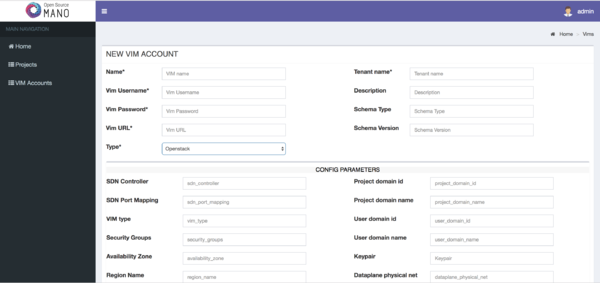
## Deploying your first Network Service
In this example we will deploy the following Network Service, consisting of two simple VNFs based on CirrOS connected by a simple VLD.
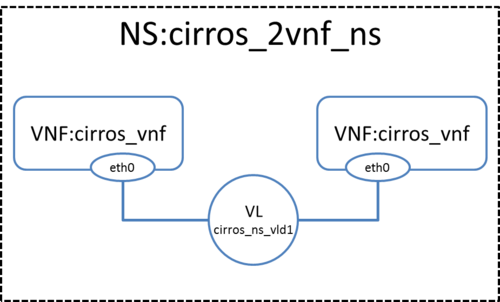
Before going on, download the required VNF and NS packages from this URL:
### Onboarding a VNF
The onboarding of a VNF in OSM involves adding the corresponding VNF package to the system. This process also assumes, as a pre-condition, that the corresponding VM images are available in the VIM(s) where it will be instantiated.
#### Uploading VM image(s) to the VIM(s)
In this example, only a vanilla CirrOS 0.3.4 image is need. It can be obtained from the following link:
If not available, it would be required to upload the image into the VIM. Instructions differ from one VIM to another:
- In Openstack:
```bash
openstack image create --file="./cirros-0.3.4-x86_64-disk.img" --container-format=bare --disk-format=qcow2 cirros034
```
- In OpenVIM:
```bash
#copy your image to the NFS shared folder (e.g. /mnt/openvim-nfs)
cp ./cirros-0.3.4-x86_64-disk.img /mnt/openvim-nfs/
openvim image-create --name cirros034 --path /mnt/openvim-nfs/cirros-0.3.4-x86_64-disk.img
```
#### VNF package onboarding
- From the UI:
- Go to Projects --> Admin --> VNF Packages (*Open List*)
- Click on the Onboard VNFD button
- Drag and drop the VNF package file cirros_vnf.tar.gz in the importing area.
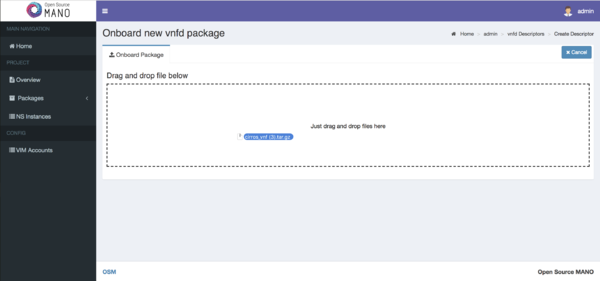
- From OSM client:
```bash
osm vnfd-create cirros_vnf.tar.gz
osm vnfd-list
```
### Onboarding a NS
- From the UI:
- Go to Projects --> Admin --> NS Packages (*Open List*)
- Click on the Onboard NSD button
- Drag and drop the NS package file cirros_2vnf_ns.tar.gz in the importing area.
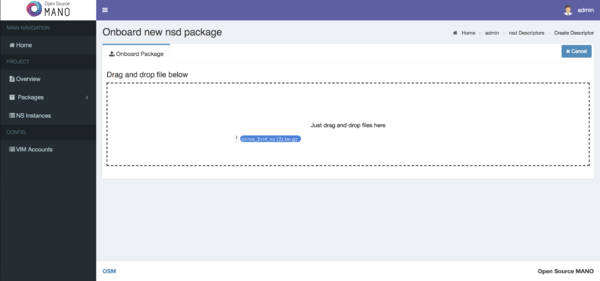
- From OSM client:
```bash
osm nsd-create cirros_2vnf_ns.tar.gz
osm nsd-list
```
### Instantiating the NS
- From the UI:
- Go to Projects --> Admin --> NS Packages (*Open List*)
- Next the NS descriptor to be instantiated, click on Launch

- Fill in the form, adding at least a name and selecting the VIM
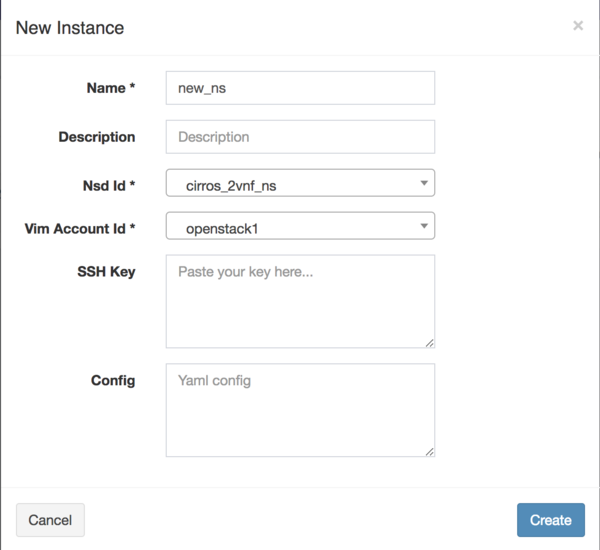
- From OSM client:
```bash
osm ns-create --nsd_name cirros_2vnf_ns --ns_name --vim_account
osm ns-list
```
**Instantiation parameters can be specified using both CLI and UI. You can find a thorough explanation with examples in this page: [OSM instantiation parameters](05-osm-usage.md#advanced-instantiation-using-instantiation-parameters).**
## What's next?
If you want to learn more, you can refer to the rest of **[OSM documentation](index.md)**.